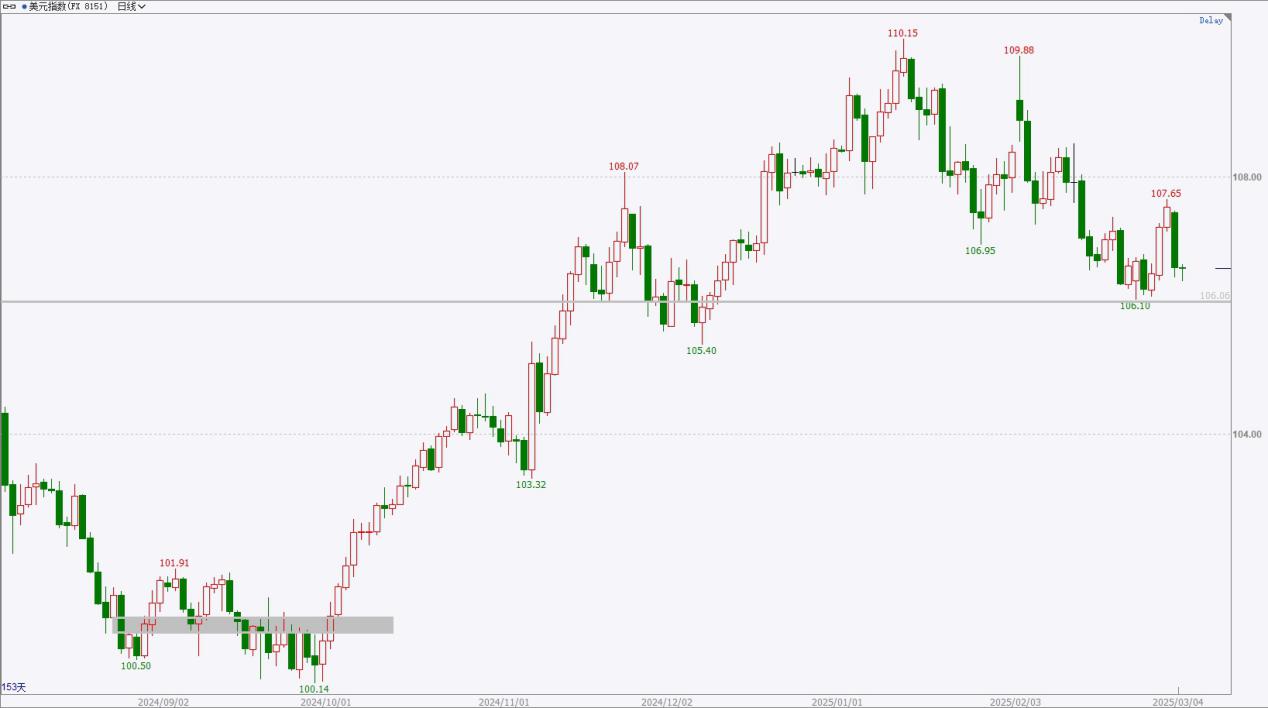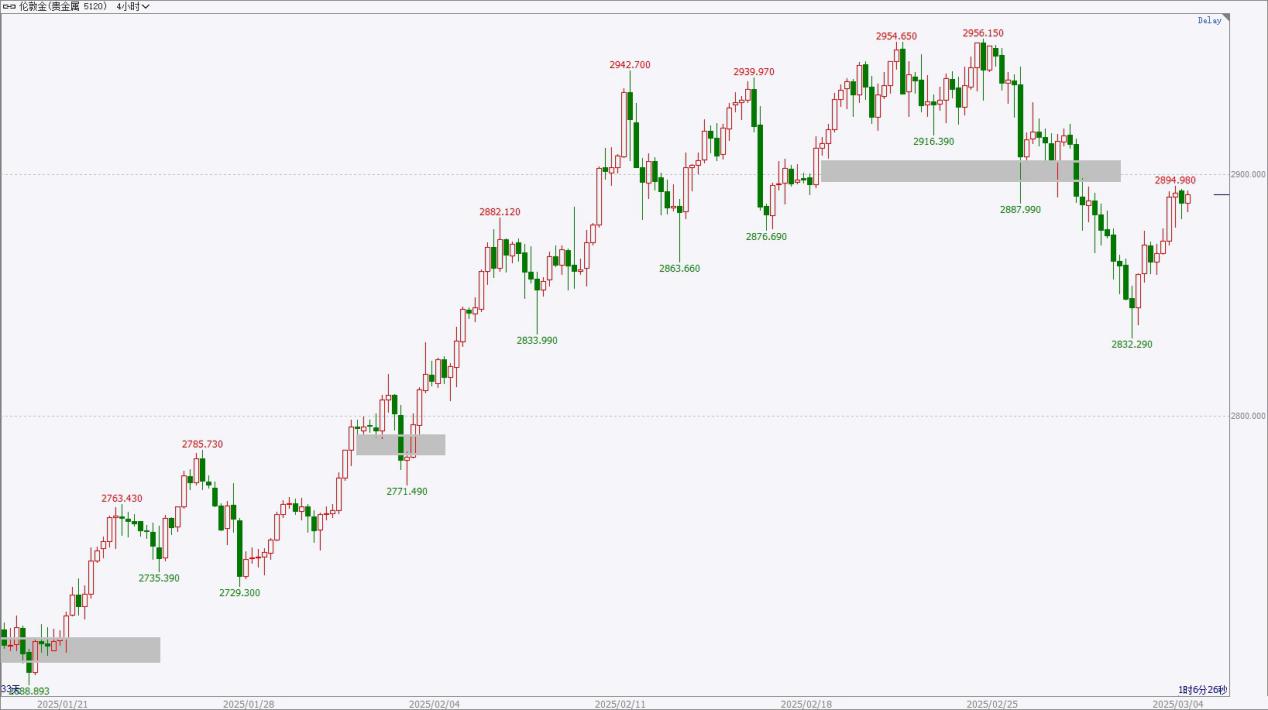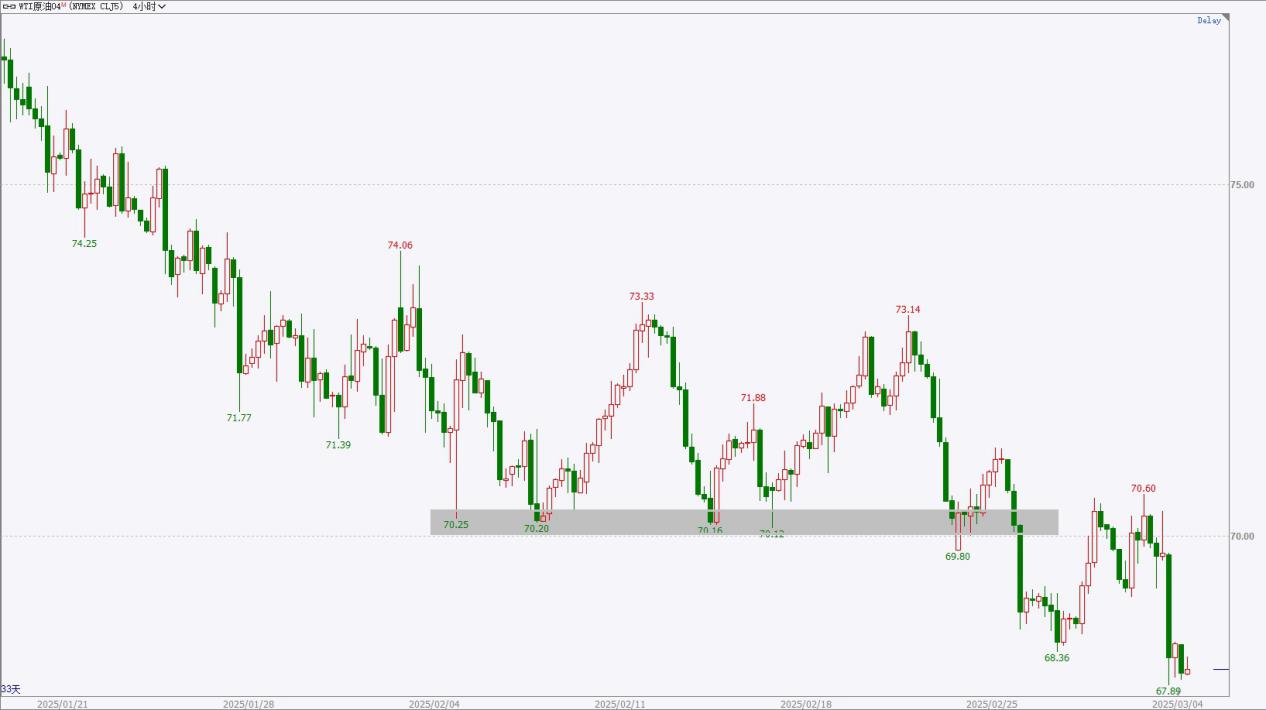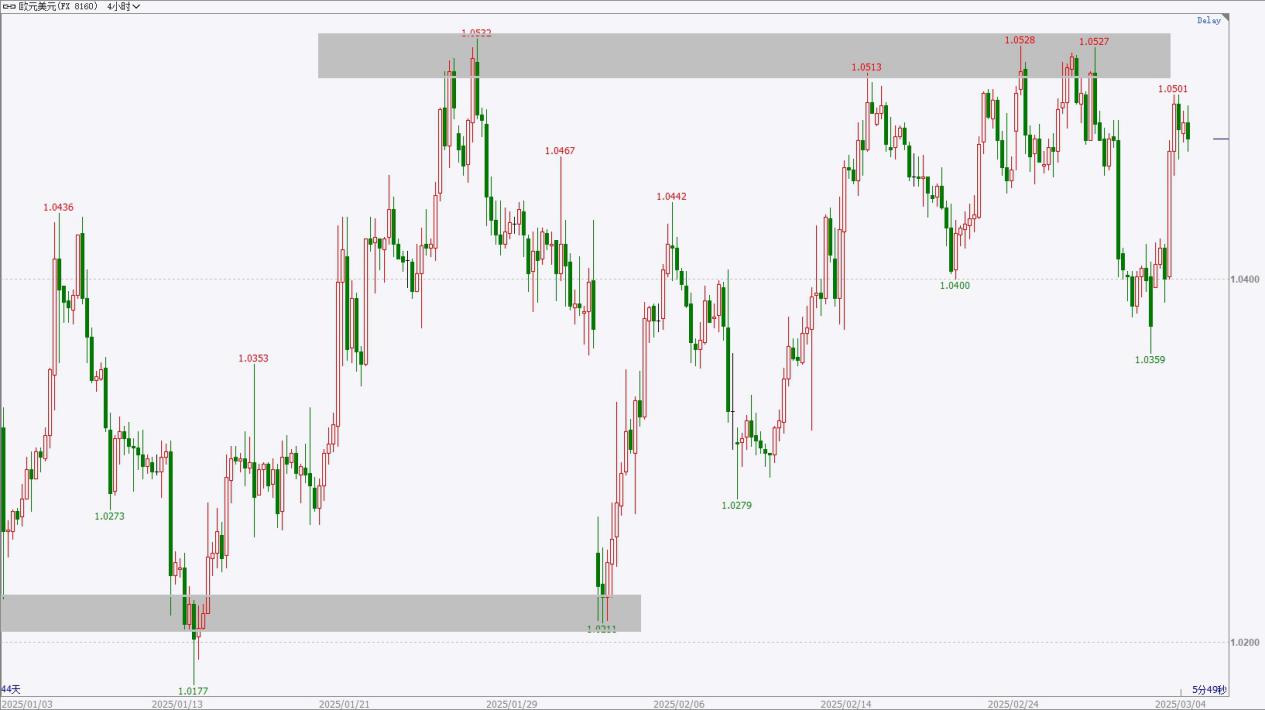|
Time
|
Data and Events
|
Importance
|
|
To be determined
|
The United States imposes a 25% tariff on Canada and Mexico.
|
★★★
|
|
07:30
|
Japan’s January unemployment rate
|
★★★
|
|
08:30
|
Reserve Bank of Australia releases minutes from the February monetary policy meeting
|
★★★
|
|
18:00
|
Eurozone’s January unemployment rate
|
★★★
|
|
Next day
03:20
|
FOMC permanent voter Williams speaks at the Bloomberg Investment Forum
|
★★★
|
|
Variety
|
Viewpoint
|
Support range
|
Resistance range
|
|
US Dollar Index
|
Weak oscillation
|
105.5-106
|
108.5-109
|
|
Gold
|
Short-term rebound
|
2830-2850
|
2900-2920
|
|
Crude oil
|
Weak oscillation
|
66-67
|
72-73
|
|
Euro
|
Short-term adjustment
|
1.0180-1.0200
|
1.0500-1.0550
|
*Pre-market views are time-sensitive and limited, are predictive in nature, intended for reference and learning only, do not constitute investment advice, and the risk of action is borne by the individual. Investment carries risks; trading must be cautious.
Fundamental Analysis:
At the end of January, the Federal Reserve meeting maintained interest rates, with a strong labor market and steady economic expansion. Inflation levels remain slightly high, with expectations for monetary policy easing cooling down. Attention will be on new government policies. January non-farm payroll data showed a decrease of 143,000 new jobs, lower than expected, while the unemployment rate slightly fell to 4.0%, indicating a robust labor market. The January unadjusted CPI year-over-year was recorded at 3.0%, slightly above the previous and expected values. January core PCE price index year-over-year slightly retreated, meeting expectations. Focus on Friday’s non-farm data.
Technical Analysis:

The US Dollar Index experienced a significant drop yesterday, with a large bearish candle on the daily chart, facing resistance above. It is currently close to the support area; if it continues to break below the structure, the market will further weaken. Overall, the daily chart shows signs of weakening after oscillating at high levels, with short-term potential for continued weak pullback. The smaller resistance area is around 108.5-109, while support is around 105.5-106.
Viewpoint: Weak oscillation, pay attention to the support structure; if it breaks, the weakness will continue.
*Pre-market views are time-sensitive and limited, are predictive in nature, intended for reference and learning only, do not constitute investment advice, and the risk of action is borne by the individual. Investment carries risks; trading must be cautious.
Fundamental Analysis:
The Middle East geopolitical conflict continues to worsen, and the situation in Eastern Europe is turbulent and uncertain. The ECB’s January interest rate decision saw a consecutive fourth rate cut of 25 bps, with inflation mostly meeting expectations while the economy continues to face pressure. The Federal Reserve’s January interest rate decision maintained rates, with good economic performance but inflation remaining high, easing the expectations for rate cuts. The US January non-farm data performed moderately, with a reduction in new job numbers below expectations, while the unemployment rate slightly improved, outperforming expectations; January CPI year-over-year showed slight warming, being slightly above expectations.
Technical Analysis:

Gold prices rebounded significantly yesterday, showing signs of upward movement on a small cycle, currently approaching the resistance area, likely to face selling pressure. If holding long positions, consider selling on gains, and watch whether prices can break upward significantly; otherwise, short-term volatility may occur. Looking at the larger cycle, the upward structure remains intact, and the daily chart is showing oscillation upwards, with prices reaching new highs repeatedly. The upper resistance level may be around 2900-2920, while the lower small-level support may be around 2830-2850.
Viewpoint: Short-term rebound, approaching resistance structure, watch for the possibility of a breakout.
*Pre-market views are time-sensitive and limited, are predictive in nature, intended for reference and learning only, do not constitute investment advice, and the risk of action is borne by the individual. Investment carries risks; trading must be cautious.
Fundamental Analysis:
In February’s EIA monthly report, the forecast for global oil demand growth in the next two years was maintained, with a slight adjustment to oil prices in 2025; OPEC’s monthly report also maintained the expectation for global oil demand growth in the next two years; IEA’s monthly report slightly raised the forecast for global oil demand growth in 2025. At the beginning of February, the OPEC+ meeting adhered to the previous oil production agreement, and the committee agreed to gradually increase oil production starting from April 1, in line with previous plans. EIA crude oil inventories declined below expectations, which may affect the supply-demand structure. Attention is on Wednesday’s EIA crude oil inventory report.
Technical Analysis:

U.S. crude oil prices fell sharply in after-hours trading, with the short cycle continuing to hit new lows and short-term performance appearing weak. The current price is at a relatively low level, and short positions should take profits on the dips instead of excessively pursuing more shorts; the focus should be on holding short positions in the short term. Overall, oil prices are fluctuating with a slight upward bias, showing signs of stabilization at a larger scale, and a short-term pullback is expected. The upper pressure area is around 72-73, while the lower support area is around 66-67.
Viewpoint: Fluctuating with a slight weakness; if there are short positions, take profits on the dips.
*Pre-market views are time-sensitive and limited, are predictive in nature, intended for reference and learning only, do not constitute investment advice, and the risk of action is borne by the individual. Investment carries risks; trading must be cautious.
Fundamental Analysis:
The ECB’s interest rate decision at the end of January saw a continuous fourth rate cut of 25 basis points, with inflation generally meeting expectations and expected to return to mid-term targets this year. The economy still faces challenges, and there may continue to be weakness in the short term, with income and policy effects supporting a rebound in demand. In late January, the Fed’s rate decision maintained interest rates unchanged, with overall economic performance being strong and easing expectations somewhat alleviated. U.S. non-farm payrolls in January showed average performance, with new jobs decreasing and the unemployment rate slightly falling; U.S. January CPI year-on-year slightly warmed. The manufacturing PMI in the eurozone showed little change. Attention is on Thursday’s ECB meeting.
Technical Analysis:

The euro price rebounded sharply yesterday, with the short cycle showing upward fluctuations, but it did not significantly break the pressure structure, which may indicate selling pressure, suggesting a high probability of short-term fluctuations. If the structure is broken, the market may strengthen. Overall, prices are at relatively low levels, with daily fluctuations suggesting the potential for larger stabilization signals. The upper pressure area is around 1.0500-1.0550, while the lower support area is around 1.0180-1.0200.
Viewpoint: Short-term adjustments are expected, with pressure above and support below, likely leading to a fluctuating market.
*Pre-market views are time-sensitive and limited, are predictive in nature, intended for reference and learning only, do not constitute investment advice, and the risk of action is borne by the individual. Investment carries risks; trading must be cautious.


Daily Reviews
Our award-winning team of analysts provides keen and insightful technical and fundamental analysis to understand daily market news and investment trading opportunities
HTFX Daily Forex Commentary 0304
Time
Data and Events
Importance
To be determined
The United States imposes a 25% tariff on Canada and Mexico.
★★★
07:30
Japan’s January unemployment rate
★★★
08:30
Reserve Bank of Australia releases minutes from the February monetary policy meeting
★★★
18:00
Eurozone’s January unemployment rate
★★★
Next day
03:20
FOMC permanent voter Williams speaks at the Bloomberg Investment Forum
★★★
Variety
Viewpoint
Support range
Resistance range
US Dollar Index
Weak oscillation
105.5-106
108.5-109
Gold
Short-term rebound
2830-2850
2900-2920
Crude oil
Weak oscillation
66-67
72-73
Euro
Short-term adjustment
1.0180-1.0200
1.0500-1.0550
*Pre-market views are time-sensitive and limited, are predictive in nature, intended for reference and learning only, do not constitute investment advice, and the risk of action is borne by the individual. Investment carries risks; trading must be cautious.
Fundamental Analysis:
At the end of January, the Federal Reserve meeting maintained interest rates, with a strong labor market and steady economic expansion. Inflation levels remain slightly high, with expectations for monetary policy easing cooling down. Attention will be on new government policies. January non-farm payroll data showed a decrease of 143,000 new jobs, lower than expected, while the unemployment rate slightly fell to 4.0%, indicating a robust labor market. The January unadjusted CPI year-over-year was recorded at 3.0%, slightly above the previous and expected values. January core PCE price index year-over-year slightly retreated, meeting expectations. Focus on Friday’s non-farm data.
Technical Analysis:
The US Dollar Index experienced a significant drop yesterday, with a large bearish candle on the daily chart, facing resistance above. It is currently close to the support area; if it continues to break below the structure, the market will further weaken. Overall, the daily chart shows signs of weakening after oscillating at high levels, with short-term potential for continued weak pullback. The smaller resistance area is around 108.5-109, while support is around 105.5-106.
Viewpoint: Weak oscillation, pay attention to the support structure; if it breaks, the weakness will continue.
*Pre-market views are time-sensitive and limited, are predictive in nature, intended for reference and learning only, do not constitute investment advice, and the risk of action is borne by the individual. Investment carries risks; trading must be cautious.
Fundamental Analysis:
The Middle East geopolitical conflict continues to worsen, and the situation in Eastern Europe is turbulent and uncertain. The ECB’s January interest rate decision saw a consecutive fourth rate cut of 25 bps, with inflation mostly meeting expectations while the economy continues to face pressure. The Federal Reserve’s January interest rate decision maintained rates, with good economic performance but inflation remaining high, easing the expectations for rate cuts. The US January non-farm data performed moderately, with a reduction in new job numbers below expectations, while the unemployment rate slightly improved, outperforming expectations; January CPI year-over-year showed slight warming, being slightly above expectations.
Technical Analysis:
Gold prices rebounded significantly yesterday, showing signs of upward movement on a small cycle, currently approaching the resistance area, likely to face selling pressure. If holding long positions, consider selling on gains, and watch whether prices can break upward significantly; otherwise, short-term volatility may occur. Looking at the larger cycle, the upward structure remains intact, and the daily chart is showing oscillation upwards, with prices reaching new highs repeatedly. The upper resistance level may be around 2900-2920, while the lower small-level support may be around 2830-2850.
Viewpoint: Short-term rebound, approaching resistance structure, watch for the possibility of a breakout.
*Pre-market views are time-sensitive and limited, are predictive in nature, intended for reference and learning only, do not constitute investment advice, and the risk of action is borne by the individual. Investment carries risks; trading must be cautious.
Fundamental Analysis:
In February’s EIA monthly report, the forecast for global oil demand growth in the next two years was maintained, with a slight adjustment to oil prices in 2025; OPEC’s monthly report also maintained the expectation for global oil demand growth in the next two years; IEA’s monthly report slightly raised the forecast for global oil demand growth in 2025. At the beginning of February, the OPEC+ meeting adhered to the previous oil production agreement, and the committee agreed to gradually increase oil production starting from April 1, in line with previous plans. EIA crude oil inventories declined below expectations, which may affect the supply-demand structure. Attention is on Wednesday’s EIA crude oil inventory report.
Technical Analysis:
U.S. crude oil prices fell sharply in after-hours trading, with the short cycle continuing to hit new lows and short-term performance appearing weak. The current price is at a relatively low level, and short positions should take profits on the dips instead of excessively pursuing more shorts; the focus should be on holding short positions in the short term. Overall, oil prices are fluctuating with a slight upward bias, showing signs of stabilization at a larger scale, and a short-term pullback is expected. The upper pressure area is around 72-73, while the lower support area is around 66-67.
Viewpoint: Fluctuating with a slight weakness; if there are short positions, take profits on the dips.
*Pre-market views are time-sensitive and limited, are predictive in nature, intended for reference and learning only, do not constitute investment advice, and the risk of action is borne by the individual. Investment carries risks; trading must be cautious.
Fundamental Analysis:
The ECB’s interest rate decision at the end of January saw a continuous fourth rate cut of 25 basis points, with inflation generally meeting expectations and expected to return to mid-term targets this year. The economy still faces challenges, and there may continue to be weakness in the short term, with income and policy effects supporting a rebound in demand. In late January, the Fed’s rate decision maintained interest rates unchanged, with overall economic performance being strong and easing expectations somewhat alleviated. U.S. non-farm payrolls in January showed average performance, with new jobs decreasing and the unemployment rate slightly falling; U.S. January CPI year-on-year slightly warmed. The manufacturing PMI in the eurozone showed little change. Attention is on Thursday’s ECB meeting.
Technical Analysis:
The euro price rebounded sharply yesterday, with the short cycle showing upward fluctuations, but it did not significantly break the pressure structure, which may indicate selling pressure, suggesting a high probability of short-term fluctuations. If the structure is broken, the market may strengthen. Overall, prices are at relatively low levels, with daily fluctuations suggesting the potential for larger stabilization signals. The upper pressure area is around 1.0500-1.0550, while the lower support area is around 1.0180-1.0200.
Viewpoint: Short-term adjustments are expected, with pressure above and support below, likely leading to a fluctuating market.
*Pre-market views are time-sensitive and limited, are predictive in nature, intended for reference and learning only, do not constitute investment advice, and the risk of action is borne by the individual. Investment carries risks; trading must be cautious.
Latest Reviews
HTFX Daily Forex Commentary 0819
HTFX Daily Forex Commentary 0815
HTFX Daily Forex Commentary 0812
HTFX Daily Forex Commentary 0811
Choose a Trusted Broker for Trading
Over 300 employees worldwide, more than 1,000 products, top-tier liquidity